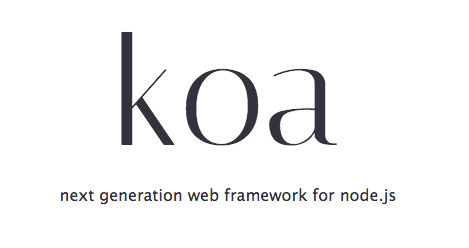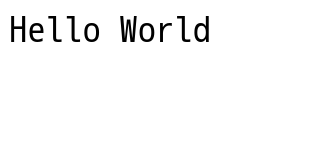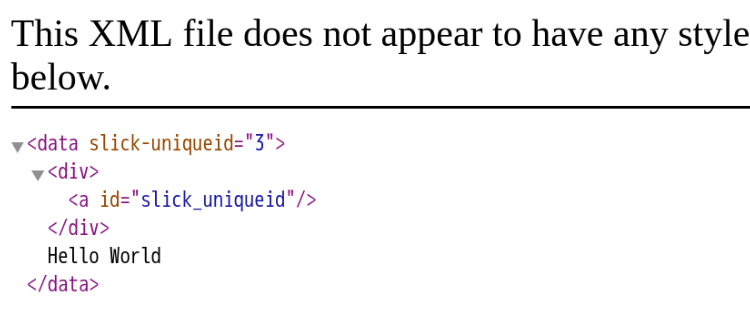Node 主要用在开发 Web 应用。这决定了使用 Node,往往离不开 Web 应用框架。

Koa 就是一种简单好用的 Web 框架。它的特点是优雅、简洁、表达力强、自由度高。本身代码只有1000多行,所有功能都通过插件实现,很符合 Unix 哲学。
本文从零开始,循序渐进,教会你如何使用 Koa 写出自己的 Web 应用。每一步都有简洁易懂的示例,希望让大家一看就懂。
零、准备
首先,检查 Node 版本。
$ node -v v8.0.0
Koa 必须使用 7.6 以上的版本。如果你的版本低于这个要求,就要先升级 Node。
然后,克隆本文的配套示例库。(如果不方便使用 Git,也可以下载 zip 文件解压。)
$ git clone https://github.com/ruanyf/koa-demos.git
接着,进入示例库,安装依赖。
$ cd koa-demos $ npm install
所有示例源码,都在 demos 目录下面。
一、基本用法
1.1 架设 HTTP 服务
只要三行代码,就可以用 Koa 架设一个 HTTP 服务。
// demos/01.js const Koa = require(‘koa‘); const app = new Koa(); app.listen(3000);
运行这个脚本。
$ node demos/01.js
打开浏览器,访问 http://127.0.0.1:3000 。你会看到页面显示"Not Found",表示没有发现任何内容。这是因为我们并没有告诉 Koa 应该显示什么内容。

1.2 Context 对象
Koa 提供一个 Context 对象,表示一次对话的上下文(包括 HTTP 请求和 HTTP 回复)。通过加工这个对象,就可以控制返回给用户的内容。
Context.response.body属性就是发送给用户的内容。请看下面的例子(完整的代码看这里)。
// demos/02.js const Koa = require(‘koa‘); const app = new Koa(); const main = ctx => { ctx.response.body = ‘Hello World‘; }; app.use(main); app.listen(3000);
上面代码中,main函数用来设置ctx.response.body。然后,使用app.use方法加载main函数。
你可能已经猜到了,ctx.response代表 HTTP Response。同样地,ctx.request代表 HTTP Request。
运行这个 demo。
$ node demos/02.js
访问 http://127.0.0.1:3000 ,现在就可以看到"Hello World"了。

1.3 HTTP Response 的类型
Koa 默认的返回类型是text/plain,如果想返回其他类型的内容,可以先用ctx.request.accepts判断一下,客户端希望接受什么数据(根据 HTTP Request 的Accept字段),然后使用ctx.response.type指定返回类型。请看下面的例子(完整代码看这里)。
// demos/03.js const main = ctx => { if (ctx.request.accepts(‘xml‘)) { ctx.response.type = ‘xml‘; ctx.response.body = ‘<data>Hello World</data>‘; } else if (ctx.request.accepts(‘json‘)) { ctx.response.type = ‘json‘; ctx.response.body = { data: ‘Hello World‘ }; } else if (ctx.request.accepts(‘html‘)) { ctx.response.type = ‘html‘; ctx.response.body = ‘<p>Hello World</p>‘; } else { ctx.response.type = ‘text‘; ctx.response.body = ‘Hello World‘; } };
运行这个 demo。
$ node demos/03.js
访问 http://127.0.0.1:3000 ,现在看到的就是一个 XML 文档了。

1.4 网页模板
实际开发中,返回给用户的网页往往都写成模板文件。我们可以让 Koa 先读取模板文件,然后将这个模板返回给用户。请看下面的例子(完整代码看这里)。
// demos/04.js const fs = require(‘fs‘); const main = ctx => { ctx.response.type = ‘html‘; ctx.response.body = fs.createReadStream(‘./demos/template.html‘); };
运行这个 Demo。
$ node demos/04.js
访问 http://127.0.0.1:3000 ,看到的就是模板文件的内容了。

二、路由
2.1 原生路由
网站一般都有多个页面。通过ctx.request.path可以获取用户请求的路径,由此实现简单的路由。请看下面的例子(完整代码看这里)。
// demos/05.js const main = ctx => { if (ctx.request.path !== ‘/‘) { ctx.response.type = ‘html‘; ctx.response.body = ‘<a href="/">Index Page</a>‘; } else { ctx.response.body = ‘Hello World‘; } };
运行这个 demo。
$ node demos/05.js
访问 http://127.0.0.1:3000/about ,可以看到一个链接,点击后就跳到首页。

2.2 koa-route 模块
原生路由用起来不太方便,我们可以使用封装好的koa-route模块。请看下面的例子(完整代码看这里)。
// demos/06.js const route = require(‘koa-route‘); const about = ctx => { ctx.response.type = ‘html‘; ctx.response.body = ‘<a href="/">Index Page</a>‘; }; const main = ctx => { ctx.response.body = ‘Hello World‘; }; app.use(route.get(‘/‘, main)); app.use(route.get(‘/about‘, about));
上面代码中,根路径/的处理函数是main,/about路径的处理函数是about。
运行这个 demo。
$ node demos/06.js
访问 http://127.0.0.1:3000/about ,效果与上一个例子完全相同。
2.3 静态资源
如果网站提供静态资源(图片、字体、样式表、脚本......),为它们一个个写路由就很麻烦,也没必要。koa-static模块封装了这部分的请求。请看下面的例子(完整代码看这里)。
// demos/12.js const path = require(‘path‘); const serve = require(‘koa-static‘); const main = serve(path.join(__dirname)); app.use(main);
运行这个 Demo。
$ node demos/12.js
访问 http://127.0.0.1:3000/12.js,在浏览器里就可以看到这个脚本的内容。
2.4 重定向
有些场合,服务器需要重定向(redirect)访问请求。比如,用户登陆以后,将他重定向到登陆前的页面。ctx.response.redirect()方法可以发出一个302跳转,将用户导向另一个路由。请看下面的例子(完整代码看这里)。
// demos/13.js const redirect = ctx => { ctx.response.redirect(‘/‘); ctx.response.body = ‘<a href="/">Index Page</a>‘; }; app.use(route.get(‘/redirect‘, redirect));
运行这个 demo。
$ node demos/13.js
访问 http://127.0.0.1:3000/redirect ,浏览器会将用户导向根路由。
三、中间件
3.1 Logger 功能
Koa 的最大特色,也是最重要的一个设计,就是中间件(middleware)。为了理解中间件,我们先看一下 Logger (打印日志)功能的实现。
最简单的写法就是在main函数里面增加一行(完整代码看这里)。
// demos/07.js const main = ctx => { console.log(`${Date.now()} ${ctx.request.method} ${ctx.request.url}`); ctx.response.body = ‘Hello World‘; };
运行这个 Demo。
$ node demos/07.js
访问 http://127.0.0.1:3000 ,命令行就会输出日志。
1502144902843 GET /
3.2 中间件的概念
上一个例子里面的 Logger 功能,可以拆分成一个独立函数(完整代码看这里)。
// demos/08.js const logger = (ctx, next) => { console.log(`${Date.now()} ${ctx.request.method} ${ctx.request.url}`); next(); } app.use(logger);
像上面代码中的logger函数就叫做"中间件"(middleware),因为它处在 HTTP Request 和 HTTP Response 中间,用来实现某种中间功能。app.use()用来加载中间件。
基本上,Koa 所有的功能都是通过中间件实现的,前面例子里面的main也是中间件。每个中间件默认接受两个参数,第一个参数是 Context 对象,第二个参数是next函数。只要调用next函数,就可以把执行权转交给下一个中间件。
运行这个 demo。
$ node demos/08.js
访问 http://127.0.0.1:3000 ,命令行窗口会显示与上一个例子相同的日志输出。
3.3 中间件栈
多个中间件会形成一个栈结构(middle stack),以"先进后出"(first-in-last-out)的顺序执行。
- 最外层的中间件首先执行。
- 调用
next函数,把执行权交给下一个中间件。- ...
- 最内层的中间件最后执行。
- 执行结束后,把执行权交回上一层的中间件。
- ...
- 最外层的中间件收回执行权之后,执行
next函数后面的代码。
请看下面的例子(完整代码看这里)。
// demos/09.js const one = (ctx, next) => { console.log(‘>> one‘); next(); console.log(‘<< one‘); } const two = (ctx, next) => { console.log(‘>> two‘); next(); console.log(‘<< two‘); } const three = (ctx, next) => { console.log(‘>> three‘); next(); console.log(‘<< three‘); } app.use(one); app.use(two); app.use(three);
运行这个 demo。
$ node demos/09.js
访问 http://127.0.0.1:3000 ,命令行窗口会有如下输出。
>> one >> two >> three << three << two << one
如果中间件内部没有调用next函数,那么执行权就不会传递下去。作为练习,你可以将two函数里面next()这一行注释掉再执行,看看会有什么结果。
3.4 异步中间件
迄今为止,所有例子的中间件都是同步的,不包含异步操作。如果有异步操作(比如读取数据库),中间件就必须写成 async 函数。请看下面的例子(完整代码看这里)。
// demos/10.js const fs = require(‘fs.promised‘); const Koa = require(‘koa‘); const app = new Koa(); const main = async function (ctx, next) { ctx.response.type = ‘html‘; ctx.response.body = await fs.readFile(‘./demos/template.html‘, ‘utf8‘); }; app.use(main); app.listen(3000);
上面代码中,fs.readFile是一个异步操作,必须写成await fs.readFile(),然后中间件必须写成 async 函数。
运行这个 demo。
$ node demos/10.js
访问 http://127.0.0.1:3000 ,就可以看到模板文件的内容。
3.5 中间件的合成
koa-compose模块可以将多个中间件合成为一个。请看下面的例子(完整代码看这里)。
// demos/11.js const compose = require(‘koa-compose‘); const logger = (ctx, next) => { console.log(`${Date.now()} ${ctx.request.method} ${ctx.request.url}`); next(); } const main = ctx => { ctx.response.body = ‘Hello World‘; }; const middlewares = compose([logger, main]); app.use(middlewares);
运行这个 demo。
$ node demos/11.js
访问 http://127.0.0.1:3000 ,就可以在命令行窗口看到日志信息。
四、错误处理
4.1 500 错误
如果代码运行过程中发生错误,我们需要把错误信息返回给用户。HTTP 协定约定这时要返回500状态码。Koa 提供了ctx.throw()方法,用来抛出错误,ctx.throw(500)就是抛出500错误。请看下面的例子(完整代码看这里)。
// demos/14.js const main = ctx => { ctx.throw(500); };
运行这个 demo。
$ node demos/14.js
访问 http://127.0.0.1:3000,你会看到一个500错误页"Internal Server Error"。

4.2 404错误
如果将ctx.response.status设置成404,就相当于ctx.throw(404),返回404错误。请看下面的例子(完整代码看这里)。
// demos/15.js const main = ctx => { ctx.response.status = 404; ctx.response.body = ‘Page Not Found‘; };
运行这个 demo。
$ node demos/15.js
访问 http://127.0.0.1:3000 ,你就看到一个404页面"Page Not Found"。

4.3 处理错误的中间件
为了方便处理错误,最好使用try...catch将其捕获。但是,为每个中间件都写try...catch太麻烦,我们可以让最外层的中间件,负责所有中间件的错误处理。请看下面的例子(完整代码看这里)。
// demos/16.js const handler = async (ctx, next) => { try { await next(); } catch (err) { ctx.response.status = err.statusCode || err.status || 500; ctx.response.body = { message: err.message }; } }; const main = ctx => { ctx.throw(500); }; app.use(handler); app.use(main);
运行这个 demo。
$ node demos/16.js
访问 http://127.0.0.1:3000 ,你会看到一个500页,里面有报错提示 {"message":"Internal Server Error"}。

4.4 error 事件的监听
运行过程中一旦出错,Koa 会触发一个error事件。监听这个事件,也可以处理错误。请看下面的例子(完整代码看这里)。
// demos/17.js const main = ctx => { ctx.throw(500); }; app.on(‘error‘, (err, ctx) => console.error(‘server error‘, err); );
运行这个 demo。
$ node demos/17.js
访问 http://127.0.0.1:3000 ,你会在命令行窗口看到"server error xxx"。
4.5 释放 error 事件
需要注意的是,如果错误被try...catch捕获,就不会触发error事件。这时,必须调用ctx.app.emit(),手动释放error事件,才能让监听函数生效。请看下面的例子(完整代码看这里)。
// demos/18.js` const handler = async (ctx, next) => { try { await next(); } catch (err) { ctx.response.status = err.statusCode || err.status || 500; ctx.response.type = ‘html‘; ctx.response.body = ‘<p>Something wrong, please contact administrator.</p>‘; ctx.app.emit(‘error‘, err, ctx); } }; const main = ctx => { ctx.throw(500); }; app.on(‘error‘, function(err) { console.log(‘logging error ‘, err.message); console.log(err); });
上面代码中,main函数抛出错误,被handler函数捕获。catch代码块里面使用ctx.app.emit()手动释放error事件,才能让监听函数监听到。
运行这个 demo。
$ node demos/18.js
访问 http://127.0.0.1:3000 ,你会在命令行窗口看到logging error。
五、Web App 的功能
5.1 Cookies
ctx.cookies用来读写 Cookie。请看下面的例子(完整代码看这里)。
// demos/19.js const main = function(ctx) { const n = Number(ctx.cookies.get(‘view‘) || 0) + 1; ctx.cookies.set(‘view‘, n); ctx.response.body = n + ‘ views‘; }
运行这个 demo。
$ node demos/19.js
访问 http://127.0.0.1:3000 ,你会看到1 views。刷新一次页面,就变成了2 views。再刷新,每次都会计数增加1。

5.2 表单
Web 应用离不开处理表单。本质上,表单就是 POST 方法发送到服务器的键值对。koa-body模块可以用来从 POST 请求的数据体里面提取键值对。请看下面的例子(完整代码看这里)。
// demos/20.js const koaBody = require(‘koa-body‘); const main = async function(ctx) { const body = ctx.request.body; if (!body.name) ctx.throw(400, ‘.name required‘); ctx.body = { name: body.name }; }; app.use(koaBody());
运行这个 demo。
$ node demos/20.js
打开另一个命令行窗口,运行下面的命令。
$ curl -X POST --data "name=Jack" 127.0.0.1:3000 {"name":"Jack"} $ curl -X POST --data "name" 127.0.0.1:3000 name required
上面代码使用 POST 方法向服务器发送一个键值对,会被正确解析。如果发送的数据不正确,就会收到错误提示。
2.3 文件上传
koa-body模块还可以用来处理文件上传。请看下面的例子(完整代码看这里)。
// demos/21.js const os = require(‘os‘); const path = require(‘path‘); const koaBody = require(‘koa-body‘); const main = async function(ctx) { const tmpdir = os.tmpdir(); const filePaths = []; const files = ctx.request.body.files || {}; for (let key in files) { const file = files[key]; const filePath = path.join(tmpdir, file.name); const reader = fs.createReadStream(file.path); const writer = fs.createWriteStream(filePath); reader.pipe(writer); filePaths.push(filePath); } ctx.body = filePaths; }; app.use(koaBody({ multipart: true }));
运行这个 demo。
$ node demos/21.js
打开另一个命令行窗口,运行下面的命令,上传一个文件。注意,/path/to/file要更换为真实的文件路径。
$ curl --form upload=@/path/to/file http://127.0.0.1:3000 ["/tmp/file"]
六、参考链接
(完)
